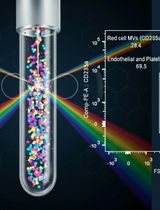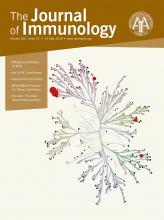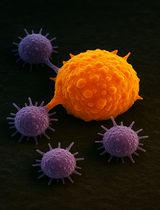- EN - English
- CN - 中文
Assessing in vitro and in vivo Trogocytosis By Murine CD4+ T cells
用小鼠CD4+T细胞评价体内外胞啃作用
发布: 2020年05月05日第10卷第9期 DOI: 10.21769/BioProtoc.3607 浏览次数: 5909
评审: Andrea PuharAndrea IntroiniAndrea GramaticaAnonymous reviewer(s)

相关实验方案

外周血中细胞外囊泡的分离与分析方法:红细胞、内皮细胞及血小板来源的细胞外囊泡
Bhawani Yasassri Alvitigala [...] Lallindra Viranjan Gooneratne
2025年11月05日 1324 阅读
Abstract
Recognition of antigens by lymphocytes (B, T, and NK) on the surface of an antigen-presenting cell (APC) leads to lymphocyte activation and the formation of an immunological synapse between the lymphocyte and the APC. At the immunological synapse APC membrane and associated membrane proteins can be transferred to the lymphocyte in a process called trogocytosis. The detection of trogocytosed molecules provides insights to the activation state, antigen specificity, and effector functions and differentiation of the lymphocytes. Here we outline our protocol for identifying trogocytosis-positive CD4+ T cells in vitro and in vivo. In vitro, antigen presenting cells are surface biotinylated and pre-loaded with magnetic polystyrene beads before incubating for a short time with in vitro activated CD4+ T cell blasts (90 min) or naïve T cells (3-24 h). After T cell recovery and APC depletion by magnetic separation trogocytosis positive (trog+) cells are identified by streptavidin staining of trogocytosed, biotinylated APC membrane proteins. Their activation phenotype, effector function, and effector differentiation are subsequently analyzed by flow cytometry immediately or after subsequent incubation. Similarly, trogocytosis-positive cells can be identified and similarly analyzed by flow cytometry. Previous studies have described methods for analyzing T cell trogocytosis to identify antigen-specific cells or the antigenic epitopes recognized by the cells. With the current protocol, the effects of trogocytosis on the individual T cell or the ability of trog+ T cells to modulate the activation and function of other immune cells can be assessed over an extended period of time.
Keywords: Trogocytosis (胞啃作用)Background
Trogocytosis is the intercellular transfer of plasma membrane and membrane-associated molecules. This phenomenon has been widely studied in the analysis of immune cell interactions and has been observed to include transfer to CD4+ (Wetzel et al., 2005; Shi et al., 2006; Adamopoulou et al., 2007; Hudrisier et al., 2007; Umeshappa and Xiang, 2010; Baba et al., 2011; Osborne and Wetzel, 2012; Reed and Wetzel, 2019), CD8+ (Hudrisier et al., 2007 and 2011; Riond et al., 2007; Gary et al., 2012; Uzana et al., 2012) and γδ T cells (Espinosa et al., 2002; Gertner et al., 2007). This phenomenon is not limited to T lymphocytes as B cells (Aucher et al., 2008; Gardell and Parker, 2017), NK cells (Carlin et al., 2001; Poupot et al., 2008; Nakayama et al., 2011; Miner et al., 2015), basophils (Miyake et al., 2017), macrophages (Daubeuf et al., 2010; Sarvari et al., 2015), neutrophils (Li et al., 2016; Valgardsdottir et al., 2017; Mercer et al., 2018), and dendritic cells (Zhang et al., 2008; Bonaccorsi et al., 2014) all perform trogocytosis (Ambudkar et al., 2005; Lis et al., 2010; LeMaoult et al., 2015).
For adaptive lymphocytes, trogocytosis leads to the presence antigen-presenting cell derived molecules on the cells. This raises the possibility that these molecules may impact the biological functions of those cells. Trogocytosis-positive (trog+) CD4+ T cells can themselves act as antigen presenting cells (Xiang et al., 2005; Shi et al., 2006; LeMaoult et al., 2007; Helft et al., 2008; Ford McIntyre et al., 2008; Umeshappa and Xiang, 2010) and we have also shown that these molecules (such as peptide-loaded MHC molecules) can interact with receptors on the cell surface (such as the T cell antigen receptor) and trigger intracellular signaling (Wetzel et al., 2005; Osborne and Wetzel, 2012; Reed and Wetzel, 2019). For T cells, acquisition of APC membrane has been used as an indicator of activation (Hudrisier et al., 2005; Puaux et al., 2006) and has been used to identify peptide-specific T cells (Puaux et al., 2006; Dhainaut and Moser, 2014) and identify T cell epitopes (Li et al., 2019). Previous methods have been published to analyze trogocytosis (Puaux et al., 2006), but with the in vitro protocol outlined here (Wetzel et al., 2005; Osborne and Wetzel, 2012; Reed and Wetzel, 2019) investigators can analyze the impact that trogocytosis has on cells for up to 7 days after recovery of APC. The in vivo protocol outlined here also makes it possible to examine how trogocytosis modulates immune responses in vivo (Kennedy et al., 2005; Adamopoulou et al., 2007; Zhou et al., 2011; Romagnoli et al., 2013; Dhainaut and Moser, 2014).
Materials and Reagents
- 1 ml syringe with 5/8 inch long, 25 gauge needle
- 5 ml and 10 ml serological pipettes
- Pipet for serological pipets (such as a Drummond pipette aid)
- Sterile 15 and 50 ml conical centrifuge tubes
- Sterile 12 x 75 polystyrene snap cap culture tubes (Falcon, catalog number: 352054 )
- Sterile 12 x 75 polystyrene culture tube with cell strainer cap (Falcon, catalog number: 352235 )
- Sterile tissue culture flask (T-25 and T-75)
- Tissue culture treated 100 mm diameter polystyrene Petri plates
- Sterile, non-tissue culture treated 100 mm polystyrene Petri plates
- Autoclaved microscope slides with ground glass ends (wrap a pair in aluminum foil with a small section between the slides to facilitate separation after autoclaving)
- SpheroTM 2.22 µm Polystyrene magnetic beads (Spherotech, Green Oaks, IL, catalog number: PM-20-10 ), store at RT
- SpheroTM 3.75 µm streptavidin-coated magnetic particles (Spherotech, Green Oaks, IL, catalog number: SVM-30-10 )
- Wild type mice to serve as donors of primary murine splenocytes and bone marrow, and recipients of adoptively transferred T cells and/or antigen immunization.
- AND or 5C.C7 T cell antigen receptor transgene mice (or other TCR transgenic, if desired)
- Bone Marrow Derived Dendritic Cells (BMDC). Preparation described in Step A1
- MCC:FKPB transfected fibroblast APC (Wetzel et al., 2005)
- EZ-Link Sulfo-NHS-Biotin (Thermo Scientific, Waltham, MA, catalog number: A39256 )
- Purified antibodies to analyze T cell phenotype and trogocytosed molecules of interest such as:
- Anti-CD4 AlexaFluor 700 (clone RM4-5, BioLegend, catalog number: 100536 )
- Anti-CD69 PE-Cy7 (clone H1.2F3, BioLegend, catalog number: 104512 )
- Anti-CD80 Pacific Blue (16-10A1, BioLegend, catalog number: 104724 )
- Anti-CD86 APC (clone GL1, BioLegend, catalog number: 105012 )
- Anti-IA/IE Brilliant Violet 421 (clone M5/114.15.2, BioLegend, catalog number: 107632 )
- To stimulate T cells, purified, azide-free anti-CD3 (clone 145.2C11, BioLegend, catalog number: 100302 ) and anti-CD28 (clone 37.51, BioLegend, catalog number: 102112 )
- To detect biotin-labeled APC membrane proteins trogocytosed by T cells, fluorochrome-conjugated streptavidin (PE-Dazzle 594, BioLegend, catalog number: 405248 ). The anti-I-Ek PE (clone 17-3-3, Thermo Fisher, catalog number: OB189809 ). The exact antibodies will be determined by the experimental parameters employed.
- Zombie Aqua Fixable Viability Stain (BioLegend, catalog number: 423101 ). Store aliquots at -20 °C, shelf life ~1 year
Note: A fixable live/dead stain is critical when performing intracellular staining. - Lympholyte-M (Cedarlane Labs, catalog number: CL5035 ). Store at 4 °C in the dark, shelf life ~5 years
- Trypan blue solution (0.4% in Phosphate Buffered Saline) (Sigma, catalog number: T6416 )
- Powdered RPMI 1640 Media (without L-glutamine or NaHCO3) (Sigma, catalog number: R6504 )
- Fetal Bovine Serum (FBS) (Atlanta Biologicals, catalog number: S1550 )
- 1 mM L-glutamine (Sigma, catalog number: G6784 )
- 100 mg/ml sodium pyruvate (Sigma, catalog number: S8636 )
- 50 mM β-Mercaptoethanol (Sigma, catalog number: P7522 )
- Essential amino acids (Sigma, catalog number: M5650 )
- Nonessential amino acids (Sigma, catalog number: M7145 )
- 100 U/ml penicillin G (Sigma, catalog number: P3032 )
- 100 U/ml streptomycin (Sigma, catalog number: S9137 )
- 50 mg/ml gentamicin (Sigma, catalog number: G1264 )
- Dulbecco’s Modified Eagle’s Media (DMEM) (Sigma, catalog number: M0518 )
- Recombinant murine Granulocyte/Monocyte Colony Stimulating factor (Peprotech, catalog number: 315-03 )
- Sigma Adjuvant System (Sigma, catalog number: S6322 )
- 500 µM moth cytochrome c 88-103 (MCC88-103) antigenic peptide* solution (in PBS, pH 7.4) Genscript (Piscataway, NJ)
Note: *Choose appropriate peptide for experimental system (insuring it binds to specific MHC Class II molecule and, if used, specific transgenic T cell antigen receptor). - Albumin from chicken egg (Ovalbumin) (Sigma, catalog number: A5503 )
- EDTA (Sigma, catalog number: ED2SS )
- Bovine Serum Albumin, fraction V (Sigma, catalog number: A9647 )
- Methanol (Fischer Scientific, catalog number: A452-4 )
- Paraformaldehyde (Sigma, catalog number: P6148 )
- Saponin (EMD Millipore, catalog number: 558255 )
- NH4Cl (Mallinckrodt Baker, catalog number: 3384-12 )
- KCl (Mallinckrodt Baker, catalog number: 6858-04 )
- Na2HPO4 (Mallinckrodt Baker, catalog number: 4062-01 )
- KH2PO4 (Sigma, catalog number: P9791 )
- Glucose (Sigma, catalog number: G7021 )
- Phenol Red (Sigma, catalog number: P3532 )
- NaOH (Fischer Scientific, catalog number S318 )
- HCl (Mallinckrodt Baker, catalog number: 9535-05 )
- MgCl2·6H2O (Sigma, catalog number: M2393 )
- MgSO4·7H2O (Sigma, catalog number: M5921 )
- CaCl2 (anhydrous) (Sigma, catalog number: C1016 )
- NaHCO3 (Sigma, catalog number: S5761 )
- Glycine (Sigma, catalog number: G8790 )
- 1x Trypsin-EDTA solution (Sigma, catalog number: 59430C )
- Triton X-100 (Sigma, catalog number: T9284 )
- Gey’s solution A (see Recipes)
- Gey’s solution B (see Recipes)
- Gey’s solution C (see Recipes)
- 1x Gey’s hypotonic solution (see Recipes)
- Spinner minimum essential medium eagle with Joklik modification (S-MEM) (Sigma, catalog number: M0518 ) (see Recipes)
- Complete media supplement (see Recipes)
- Complete RPMI (cRPMI) (see Recipes)
- Complete DMEM (cDMEM) (see Recipes)
- 10x Phosphate Buffered Saline (PBS) (see Recipes)
- 1x Sterile Phosphate Buffered Saline, pH 7.4 (see Recipes)
- 1x Sterile phosphate buffered saline, pH 8.0 (see Recipes)
- Flow cytometry staining buffer (see Recipes)
- 10% Sodium azide solution (NaN3) (see Recipes)
- 4% Paraformaldehyde (see Recipes)
Equipment
- 2 L beaker
- Stem CellTM EasySepTM Magnet (Stem Cell, catalog number: 18000 )
- P10, P20, P200, and P1000 Micropipettes and sterile pipette
- Temperature controlled, humidified cell culture incubator (5% CO2 environment)
- Laminar flow class II biosafety cabinet
- Refrigerated tabletop centrifuge
- Hemacytometer and hand tally
- Inverted phase contrast microscope with 4x, 10x, and 20x objectives
- Multicolor flow cytometer (e.g., Becton Dickinson, model: FACSAria )
- Computer for offline data analysis (Apple iMac or MacMini)
- Fume hood
- Heat plate with integrated stir motor
- Stir bars
- Nitex screen, 60 µm mesh (Elko Filtering Co., catalog number 03-60/42 )
Note: Cut into 1-inch squares. Used to filter out cell clumps before flow cytometry. Can be autoclaved if necessary.
Software
- FlowJo 8.8.7 and FlowJo 10 software (Tree Star, Ashland, OR)
Procedure
文章信息
版权信息
© 2020 The Authors; exclusive licensee Bio-protocol LLC.
如何引用
Reed, J. and Wetzel, S. A. (2020). Assessing in vitro and in vivo Trogocytosis By Murine CD4+ T cells. Bio-protocol 10(9): e3607. DOI: 10.21769/BioProtoc.3607.
分类
免疫学 > 免疫细胞功能 > 抗原特异反应
免疫学 > 免疫细胞染色 > 流式细胞术
细胞生物学 > 基于细胞的分析方法 > 流式细胞术
您对这篇实验方法有问题吗?
在此处发布您的问题,我们将邀请本文作者来回答。同时,我们会将您的问题发布到Bio-protocol Exchange,以便寻求社区成员的帮助。
Share
Bluesky
X
Copy link












